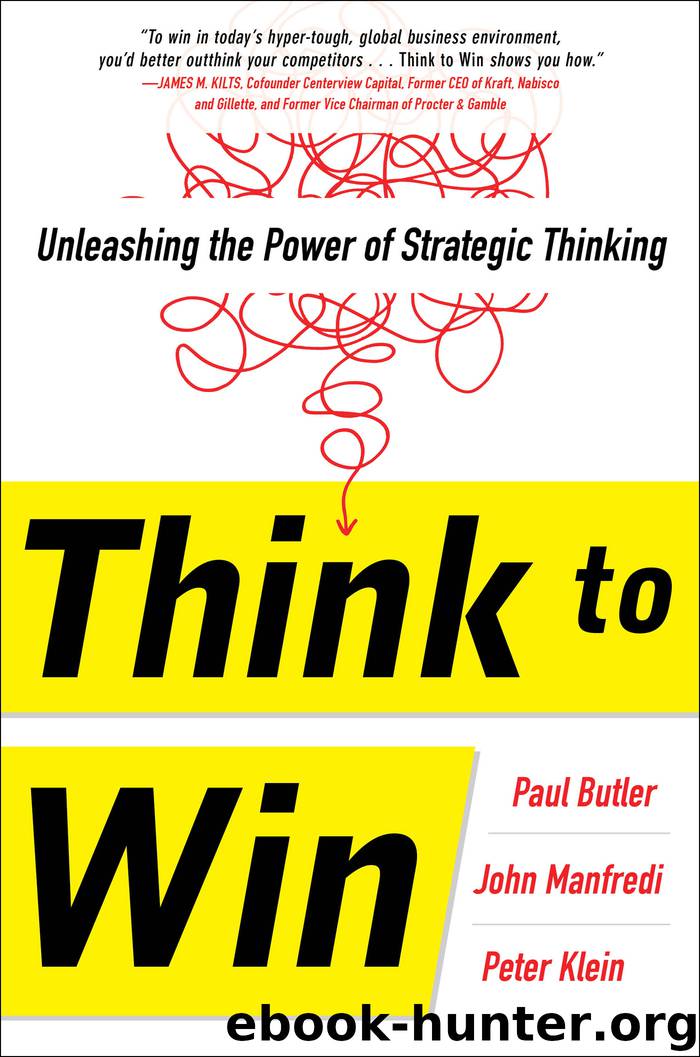Think to Win by Paul Butler & John Manfredi & Peter Klein

Author:Paul Butler & John Manfredi & Peter Klein
Language: eng
Format: epub
Publisher: McGraw-Hill Education
Published: 2015-10-07T16:00:00+00:00
FIGURE 6.1. WHAT CHOICES DO WE MAKE?
Aha Moments and Insights Inspire Strategies
To generate a list of possible strategies, we have several good approaches for you to pursue. We have found that many options originate with the aha moments we experience in the top of the hourglass. Those insights inspire novel ways of looking at a problem, and they can do the same for developing strategies.
Since we want a range of strategies to assess, we also can brainstorm to help ensure that we have both diversity and quantity. Brainstorming has been called a method for creating an idea explosion, a creativity bomb of unfiltered, unevaluated, uncensored possibilities. (See the sidebar for details on this approach.) The goal of all approaches is to generate a set of core strategies plus possible alternative approaches.
BRAINSTORMING STRATEGIC OPTIONS
Brainstorming on strategic options may bring together an unlikely cast of characters, especially if the culture of the organization is primarily left-brained or heavily risk-averse. If what is needed is disruptive innovation, the best people for the task may be your in-house disruptive innovators. In lieu of the CEO, the CFO, and a few direct reports, the brainstorming session could include the CEO, the fashionista from marketing, the brilliant geek from R&D, the bright new hire in HR, and a facilitator.
The job of the facilitator is to move the process along and keep everyone focused on the problem. He or she may be a company employee or an outside professional. Facilitators set the ground rules and then make sure that everyone sticks to them and remains focused on the problem. Even if the boss’s boss is in the room, the facilitator will find a way to remind everyone—nicely, of course—to check both their egos and their chevrons at the door.
The job of the group is to solve the problem, and given that assignment, there should be no such thing as a bad idea. This is not the time for self-censorship—it is not unusual for one participant to take another’s “crazy idea,” tweak it slightly, and come up with a winning possibility. The goal of the session is to generate strategies.
These strategies will almost always include one that says let’s stay the course, or stay the course with a few incremental adjustments. But they also should include several bolder choices. These “outside the box” options will more than likely cause upheaval and may take years to achieve, but that doesn’t mean they should be off the table.
Undertaking a major course correction may be necessary to avoid being leapfrogged or sidetracked by aggressive competitors or by factors occurring in the marketplace. The choice by WhiteWave to move beyond soy-based products into almond and other plant-based products is a good example. The choice by New Balance to add a line of clothing and open its own stores is another.
Download
This site does not store any files on its server. We only index and link to content provided by other sites. Please contact the content providers to delete copyright contents if any and email us, we'll remove relevant links or contents immediately.
Hit Refresh by Satya Nadella(9038)
The Compound Effect by Darren Hardy(8808)
Change Your Questions, Change Your Life by Marilee Adams(7635)
Nudge - Improving Decisions about Health, Wealth, and Happiness by Thaler Sunstein(7615)
The Black Swan by Nassim Nicholas Taleb(7010)
Deep Work by Cal Newport(6879)
Daring Greatly by Brene Brown(6444)
Rich Dad Poor Dad by Robert T. Kiyosaki(6401)
Principles: Life and Work by Ray Dalio(6209)
Man-made Catastrophes and Risk Information Concealment by Dmitry Chernov & Didier Sornette(5921)
Playing to Win_ How Strategy Really Works by A.G. Lafley & Roger L. Martin(5917)
Digital Minimalism by Cal Newport;(5663)
Big Magic: Creative Living Beyond Fear by Elizabeth Gilbert(5610)
The Myth of the Strong Leader by Archie Brown(5425)
The Slight Edge by Jeff Olson(5346)
Discipline Equals Freedom by Jocko Willink(5285)
The Motivation Myth by Jeff Haden(5156)
Stone's Rules by Roger Stone(5026)
The Laws of Human Nature by Robert Greene(4997)
